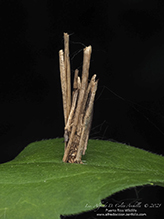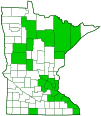common bagworm moth
(Psyche casta)
Conservation • Description • Habitat • Ecology • Distribution • Taxonomy
|
|
||||||||||||||||||
Description |
Common bagworm moth is a small exotic moth. It is native to Europe, and it was accidentally introduced into North America. It was first discovered in 1931 near Jamaica Pond in Boston Massachusetts. Since then, it has spread across the eastern United States and southern Canada, and it has recently been reported in the Pacific Northwest. It now occurs in the U.S. from Maine to Florida, west to Minnesota and eastern Texas. In the west, there is a single report from Washington and another from Oregon. The larvae feed on grasses, dead leaves, lichens, and decaying vegetable matter, and occasionally on scale insects. They are often observed on tree trunks, sometimes on foliage. Adults are active from late May to July. They do not feed. They are found in a variety of habitats. The adult male has a 7⁄16″ to ½″ (11 to 13 mm) wingspan. The head is hairy. There are two compound eyes and no simple eyes (ocelli). The antennae have 18 to 20 segments and are short, less than half as long as the forewings. They are broadly feather-like (bipectinate), with long extensions on both sides at the base of each segment. The sensory mouthparts (palps) have just one segment. They are slender and long, about four or five times as long as wide. The remaining mouthparts are much reduced and non-functional (vestigial). The forewings are rounded at the outer margin. They are unicolored, various shades of brownish gray, and they have metallic reflections. The hindwings have seven veins. On the front legs, the fourth segment (tibia) has a spur-like appendage (epiphysis) used for cleaning the antennae. The epiphysis is as long or nearly as long as the tibia. On the hind legs, the tibia has four prominent spurs. The female is ¼″ to 5⁄16″ (6 to 8 mm) in length and wingless, but otherwise similar to the male. The antennae are greatly reduced. They have many segments and are simple, not bipectinate. The abdomen has a dense tuft of long, silky hairs at the end, longest and densest on the seventh segment. |
Size |
Total length (female): ¼″ to 5⁄16″ (6 to 8 mm) Wingspan (male): 7⁄16″ to ½″ (11 to 13 mm) |
Similar Species |
Habitat |
|
Ecology |
Season |
One generation per year: late May to July |
Behavior |
The female fashions a silky bag and covers it with a case made from pieces of dried grass. She never leaves the case except to mate. The case is about ⅜″ to ½″ (11 to 13 mm) long. |
Life Cycle |
The female exits her case and clings to it while awaiting copulation with a male. After mating, she reenters the case, immediately lays eggs inside the case, then dies. When the eggs hatch, the larvae feed on the carcass of the mother. They fashion their own larval cases from pieces of the mother’s case, then they drop to the ground. They feed from the case for a year or more. When they are ready to pupate, they attach their case to a substrate, usually a tree trunk or foliage, often a fence or the side of a house. |
Larva Food |
Grasses, dead leaves, lichens, and decaying vegetable matter. Occasionally scale insects. |
Adult Food |
Adults do not feed. |
Distribution |
||
|
Sources |
|
| 10/22/2024 | ||
Occurrence |
||
Common |
||
Taxonomy |
|
Order |
|
Superfamily |
Tineoidea (bagworms, clothes moths, and allies) |
Family |
Psychidae (bagworm moths) |
Subfamily |
Psychinae |
| Tribe | Psychini |
Genus |
Psyche |
Subordinate Taxa |
|
|
|
Synonyms |
|
Bombyx nana Bombyx nitidella Bombyx vestita Bombyx viciella Eumea niphonica Fumaria muscea Fumaria nitida Fumea bowerella Fumea germanica Fumea hirsutella Fumea mitfordella Fumea nitidea Fumea ussuriensis Masonia hibernicella Phalaena casta Phalaena tubifex Psyche carpini Psyche intermediella Psyche roboricolella Tinea lucidella Tinea palearis |
|
Common Names |
|
common bagworm moth |
|
Glossary
Ocellus
Simple eye; an eye with a single lens. Plural: ocelli.
Palp
Short for pedipalp. A segmented, finger-like process of an arthropod; one is attached to each maxilla and two are attached to the labium. They function as sense organs in spiders and insects, and as weapons in scorpions. Plural: palpi or palps.
Visitor Photos |
||
Share your photo of this insect. |
||
This button not working for you? |
||
Alfredo Colon |
||
 |
||
| insect architecture |
|
|
MinnesotaSeasons.com Photos |
||
|
||
|
||

Visitor Videos |
||
Share your video of this insect. |
||
This button not working for you? |
||
|
Other Videos |
||
Never seen before insect that carries its wood house - Psyche Casta |
About
Jan 25, 2023 Music: Winter Foe |
Bagworm moth - Psyche casta - Psychidae |
About
Apr 18, 2021 Bagworm moth |
Gewone zakdrager - Psyche casta |
About
May 28, 2023 Google Translate: The common bagworm (Psyche casta) is a moth from the family Psychidae, the bagworms. The wingspan of the males is between 12 and 15 millimeters. The females have no wings. Host plants include the grass family, birch, willow, poplar and blueberry. The caterpillars, like all other bagworms, make a covering from blades of grass and small twigs to protect them. The flying period runs from May to July. The common bagworm is a common butterfly in the Netherlands and Belgium that can occur in large groups. The caterpillars are often found on tree trunks. |

Created: 12/4/2023 Last Updated: © MinnesotaSeasons.com. All rights reserved. |






